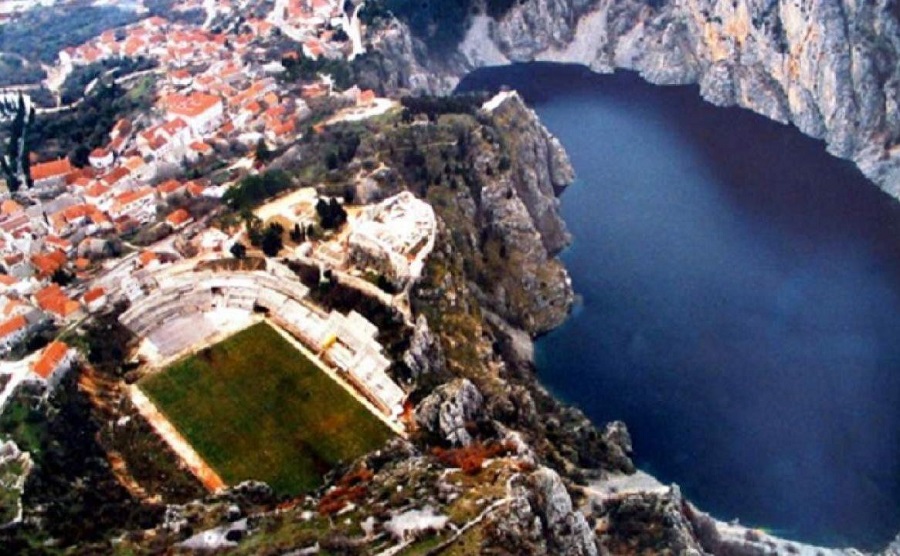Germany Adds Lika-Senj County to Red List
September 24, 2020 - The Robert Koch Institute red list now includes the French regions of Center-Val de Loire, Brittany and Normandy, Lika-Senj County in Croatia, and Notranjsko-kraška region in Slovenia.
Novi List reports that on Wednesday, Germany added regions from 11 European countries to the list of high-risk areas, including Lika-Senj County, rejecting the last hope of reviving tourism at a time when many countries are threatened by a second wave of coronavirus.
The Robert Koch Institute list includes major tourist destinations such as the French regions of Center-Val de Loire, Brittany and Normandy, Lika-Senj County in Croatia, and the Notranjsko-kraška region in Slovenia.
The list also includes the capitals of Ireland, Portugal, and Denmark, the Dutch province of Utrecht, the Austrian state of Vorarlberg, most of the Czech Republic, the county of Gyor in western Hungary, and Romania's Covasna.
The inclusion in the list of risk areas usually follows when the Ministry of Foreign Affairs publishes recommendations against necessary trips to the region in question.
Germany warns against traveling to regions in the European Union where more than 50 are infected per 100,000 people per week.
Due to the spread of the epidemic, Germany has so far included Dubrovnik-Neretva, Požega-Slavonia, Šibenik-Knin, Split-Dalmatia, Brod-Posavina, Virovitica-Podravina, and Zadar counties on the list of epidemiologically risky areas in Croatia.
Declaring an area risky means that those returning from vacation must be tested for coronavirus and remain in self-isolation until they receive a negative test result.
On Wednesday, Croatia recorded 204 new cases, and the number of active cases in Croatia is 1,268. Among them, 278 patients are in hospital, of which 27 are on a ventilator. From Tuesday to Wednesday this week, 6,387 people were tested.
For the latest travel info, bookmark our main travel info article, which is updated daily.
Read the Croatian Travel Update in your language - now available in 24 languages
Flights to Croatia: Windrose Reconnects Zagreb and Kyiv, KLM to Split and Zagreb in October
September 23, 2020 - The latest news for flights to Croatia as Windrose reconnects Zagreb and Kyiv from October, and KLM continues to fly to Split and Zagreb next month.
HRTurizam reports that Zagreb and Kyiv will soon be reconnected by a direct airline, according to Rajko Ruzicka, director of the Croatian National Tourist Board in Russia.
This is the announcement of a new Windrose airline flight, which should connect Kyiv and Zagreb twice a week from October 4, 2020, to March 24, 2021.
"Despite the global coronavirus pandemic and the overall reduction in tourist traffic in 2020, investments in the promotion of Croatia as a top tourist destination on the Ukrainian market have paid off. Charter flights from Kyiv to Pula, Split, and Dubrovnik, which operated this summer, have significantly increased the number of arrivals of Ukrainian tourists in Croatia," said Ruzicka, adding that a number of Ukrainian tourists arrived in Croatia this year by road.
Croatia realized about 230,000 overnight stays in August this year from Ukrainian tourists, which is about 80 percent of last year's result in August, and the favorite Croatian destinations of Ukrainians are Makarska Riviera, Porec, Rovinj, and Dubrovnik, where they usually stay in hotel accommodation.
Furthermore, Croatian Aviation reports that Dutch airline KLM has announced its flight schedule for October this year. Until the end of the summer flight schedule, the company will operate to two destinations in Croatia: Split and Zagreb.
The Dutch national company will continue to operate on its regular routes from Amsterdam to Zagreb and Split in October.
KLM's Amsterdam-Zagreb route was re-established on July 4 with three flights a week, every Friday, Saturday, and Sunday, and daily flights on this route are available from the beginning of August. The company operated on this line regularly, without canceling certain departures.
However, certain flights in October have already been canceled. From October 5 to 11, the company canceled flights on Tuesday and Thursday (October 6 and 8). From October 12 to the end of the month, the company offers daily flights between the two cities, but it remains to be seen whether it will cancel certain flights after mid-October, and the likelihood of this is high.
KLM's second route to Croatia, Amsterdam-Split, operated 12 to 14 times a week in August with larger capacity aircraft (B737-700, B737-800). In September, traffic was reduced to three flights per week (Fridays, Saturdays, and Sundays), and KLM plans to keep the same number of weekly flights on this route in October as it did in September. The last flight on the route Amsterdam-Split has been announced for Saturday, October 24.
E190 aircraft with a capacity of 100 passengers have been announced on both KLM routes. It is expected that KLM will operate to Zagreb in the winter months with significantly fewer weekly flights compared to last year's winter flight schedule.
Given the close partnership between KLM and Air France, there is a possibility that one of the carriers will completely stop traffic to Zagreb this winter and redirect its passengers to a partner airline; such a decision will primarily depend on the booking status and travel restrictions between individual countries.
For the latest travel info, bookmark our main travel info article, which is updated daily.
Read the Croatian Travel Update in your language - now available in 24 languages
Join the Total Croatia Travel INFO Viber community.
Flights to Croatia: Austrian Airlines Reduces Traffic to Croatia
September 22, 2020 - The latest news for flights to Croatia as Austrian Airlines reduces traffic to Croatia in October.
Austrian national airline Austrian Airlines has announced its flight schedule for October. The company will operate to three Croatian airports until mid-October; Zagreb, Split, and Dubrovnik.
As confirmed to Croatian Aviation by this airline, due to travel restrictions, Austria Airlines still decided to reduce the number of weekly flights to Croatia and end its traffic to Split earlier. As a reminder, Austrian launched the Vienna-Zadar line this summer, which was in operation until mid-September. Despite the pandemic, the company is satisfied with the results of this line and plans to continue operating on the same in the summer season of 2021.
The Vienna-Split route operated 6 times a week during the summer flight schedule, every day except Tuesday. Although Austrian planned to operate on this route throughout October, due to restrictions and low demand, the last flight will be earlier than planned - on October 10. From October 1 to October 10, the Vienna-Split route will be open three times a week, on Tuesdays, Thursdays, and Saturdays in the afternoon.
The Vienna-Dubrovnik line also operated six times a week this summer season. It will be in traffic until the very end of the summer flight schedule - October 23.
From October 2 to 5, four flights a week have been announced, on Mondays, Fridays, Saturdays, and Sundays,
From October 11 to 18, two flights a week have been announced, on Fridays and Sundays,
From October 19 to 23, two flights a week were announced, Mondays and Sundays.
Austrian is also announcing changes on the Vienna-Zagreb route. Although this line was supposed to operate 6 times a week in September, the company often canceled certain departures due to weak demand. For this reason, there has been a reduction in the number of weekly flights on the route, so Austrian will connect Vienna and Zagreb four times a week in October, every Monday, Wednesday, Friday, and Sunday. Flights were announced in the afternoon.
In the summer flight schedule of the previous years, Austrian flew to Split and Dubrovnik every day, often using its largest aircraft from the Airbus family (A321). At the same time, on the Vienna-Zagreb route, it operated up to 3 times a day. The only route that should be in traffic in this year's winter flight schedule is Vienna-Zagreb, but the number of weekly flights is still uncertain. The airline's plan for this route in the winter months should be announced in mid-October.
For the latest travel info, bookmark our main travel info article, which is updated daily.
Read the Croatian Travel Update in your language - now available in 24 languages
VIDEO: Football Match Played at Bottom of Blue Lake in Imotski for 15th Time
September 21, 2020 - The bottom of the Blue Lake in Imotski dried up at the end of August, which could only mean one thing - the traditional football match between the Vilenjaci (Elves) and Vukodlaci (Werewolves).
An Imotski tradition that has been held 15 times is a football match between the Elves and the Werewolves, played on the muddy bottom of the Blue Lake. While this spectacle is unique because of the makeshift football pitch, it is also special because there are no rules, and the result is always a draw, reports Dalmatinski Portal.
"It is a rivalry between those on the north and those on the east side of the lake. We Werewolves are charming people who would go to the other side of the lake and spend nights with fairies. After that, we didn't want to be with our wives anymore, so the mothers-in-law came up with the idea of waiting for the full moon when the fairies bathe in the lake; they bought that water and gave it to their daughters-in-law to spray on their chests," says the legend of the Werewolves, Petar Mustapic.
When the rifle fired, the teams descended to the bottom of the lake—the Elves on one side, and Werewolves on the other. The Werewolves' descent is accompanied by shouts and drums while they are greeted by the Elves with music and applause at the bottom. After presenting the teams, the mayor leads the kick-off.
Matches at the bottom of the Blue Lake have been played since the Second World War, and Sunday, this spectacle was held for the 15th time. Two halves of 30 minutes each are played, and the result is always a draw. Josko Mustapic explains why.
"If the hated enemy won, there would be blood up to the knees, so this way, we both win," he said.
Although they have no rules, that is no reason not to have a referee. And his job is particularly special - he hands out yellow cards that clearly say, 'Ne seri' and red cards that say, 'Ne pizdi.'
The role of the referee was taken over by Postenjak, and for this occasion, they even had VAR.
The last time the game was played at the bottom of the Blue Lake was in 2017.
For the latest travel info, bookmark our main travel info article, which is updated daily.
Read the Croatian Travel Update in your language - now available in 24 languages
Join the Total Croatia Travel INFO Viber community.
Flights to Croatia: LOT Will Operate to Four Croatian Airports in October
September 20, 2020 - The latest news for flights to Croatia as Polish airline LOT will operate to four Croatian airports in October.
Croatian Aviation reports that the Polish airline LOT announced its flight schedule for October, in which, among other things, it confirmed traffic on four international routes to Croatia.
In October, LOT will operate to four airports in Croatia: Zagreb, Zadar, Split, and Dubrovnik. Numerous seasonal lines that were in operation this season will stop operating by the end of September, and most lines have already finished operating (such as the new Warsaw-Rijeka line).
The Warsaw-Zagreb route will also be in operation in October, but the company has canceled certain departures (October 5, 6, 12, 14, 19, 20, and 21), so on average, LOT will fly on this line five times a week. E170 and E190 aircraft have been announced on the route.
The Warsaw-Zadar line will operate until the end of the summer flight schedule, on October 24, once a week, on Saturdays. E190 aircraft have been announced on the route.
The Warsaw-Split line will be in operation until October 18, also once a week, every Sunday. This is the only route to Croatia on which LOT uses larger capacity aircraft, B737-800.
The Warsaw-Dubrovnik line will operate 3 times a week in the first week of October (Monday, Thursday, Saturday), and then until October 24, two flights a week are available, on Mondays and Saturdays.
It is to be expected that in this year's winter flight schedule, LOT will operate only on one line to Croatia, between Warsaw and Zagreb.
Recall, we announced earlier this week that in October this year, Croatia Airlines will continue to connect Croatia with the most important European capitals and transport hubs, and air connections within Croatia will continue to be provided to passengers on domestic scheduled flights.
During October, the national airline's aircraft will directly connect Croatia with 15 international destinations (Amsterdam, Vienna, Berlin, Brussels, Düsseldorf, Frankfurt, Copenhagen, London Heathrow, Lyon, Munich, Paris, Rome, Sarajevo, Skopje, and Zurich). Passengers from these traffic hubs are provided with favorable opportunities for connecting flights worldwide, especially on the flights of Croatia Airlines partners from the Star Alliance.
In international regular traffic, Zagreb will be directly connected to 12 European destinations; from Split, it will fly to 10 European capitals, from Dubrovnik to two international destinations. From Rijeka, it will continue to fly to Munich.
In domestic scheduled traffic, Croatia Airlines planes will connect Zagreb with five Croatian airports (Split, Dubrovnik, Zadar, Pula, and Bol on the island of Brac), and flights on the Osijek - Split and Osijek - Dubrovnik routes will continue.
During the peak of the tourist season, the company's planes directly connected Zagreb with 14, Split with 11, and Dubrovnik with 7 international destinations.
For the latest travel info, bookmark our main travel info article, which is updated daily.
Read the Croatian Travel Update in your language - now available in 24 languages
Never Watched Football at the Bottom of a Lake? Imotski. Sunday.
September 18, 2020 - What is the most unusual football match you have been to? Can you beat a game between elves and werewolves at the bottom of a lake? Welcome to Imotski!
I have heard of some quite unusual sports and sporting venues on my travels over the years, but nothing quite like this.
A football match at the bottom of a lake.
The location is the gorgeous Blue Lake of Imotski in inland Dalmatia, about 30 minutes by car from the Makarska coast. Ordinarily, the Red and Blue Lakes are the town's star attractions due to their undoubted beauty, but this Sunday, attention will turn to the Blue Lake for a totally different - and very bizarre - reason.
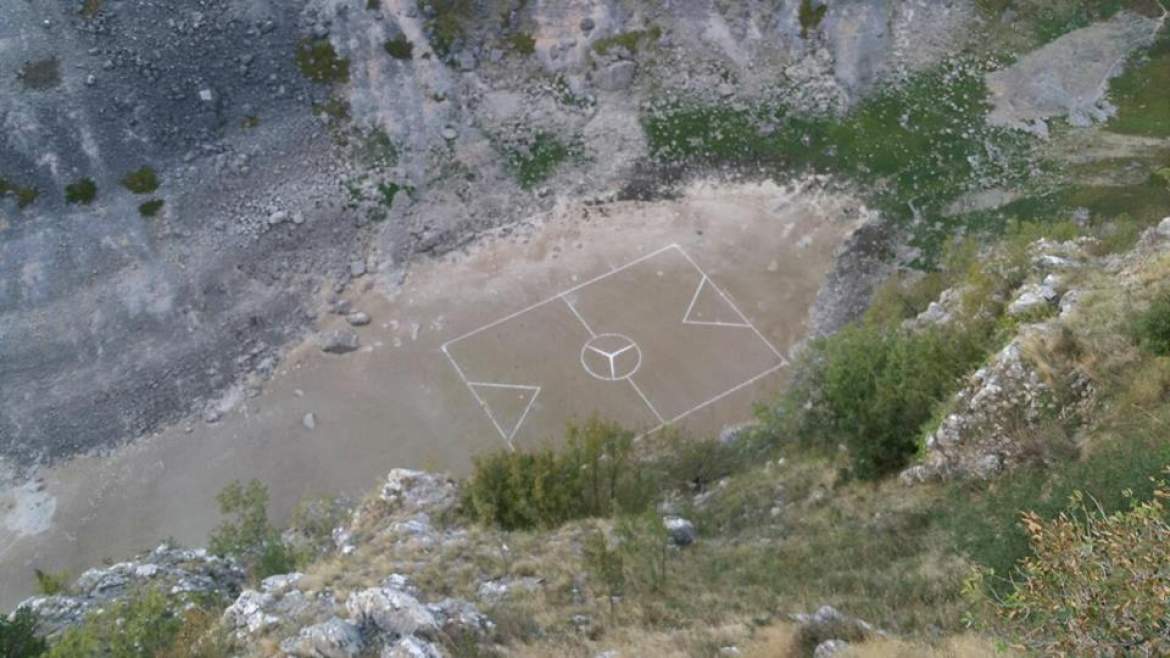
A football match at the bottom of the lake.
For the Blue Lake is no longer blue, at least for now.
In fact, the Blue Lake currently does not exist.
Depending on the time of year you visit, the level of the Blue Lake will be at a different level. It is at its fullest after the melting of snow on the nearby mountains, and its level is lowest after the hot summer season. And some years, when the summer has been particularly hot and rainfall particularly scarce, the unthinkable happens.
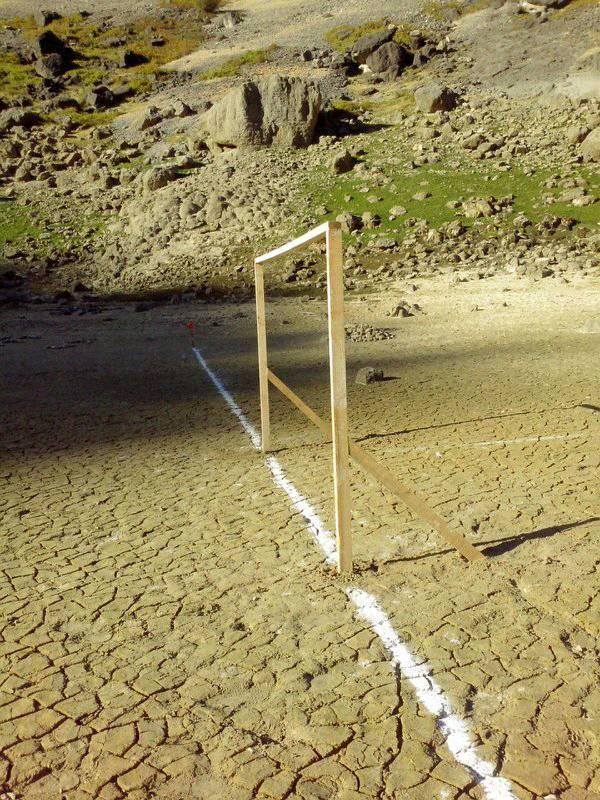
The Blue Lake disappears completely, leaving only a dry muddy bottom.
This used to happen about twice a century, but it has now happened four times in the last 30 year, including right now. And what happens when a lake dries up?
That's right - the elves and werewolves come out to play.
In what must surely be one of the most bizarre football matches and traditions on the planet, two teams known as the Vukodlaci (Werewolves) & Vilenjaci (Elves) take advantage of the dryness of this most unusual football pitch to battle for local bragging rights.
The match last took place in October, 2017, and you can watch an excellent video report of that occasion in the video above.
This year's match will take place this Sunday, September 20, with kick-off at 15:00.
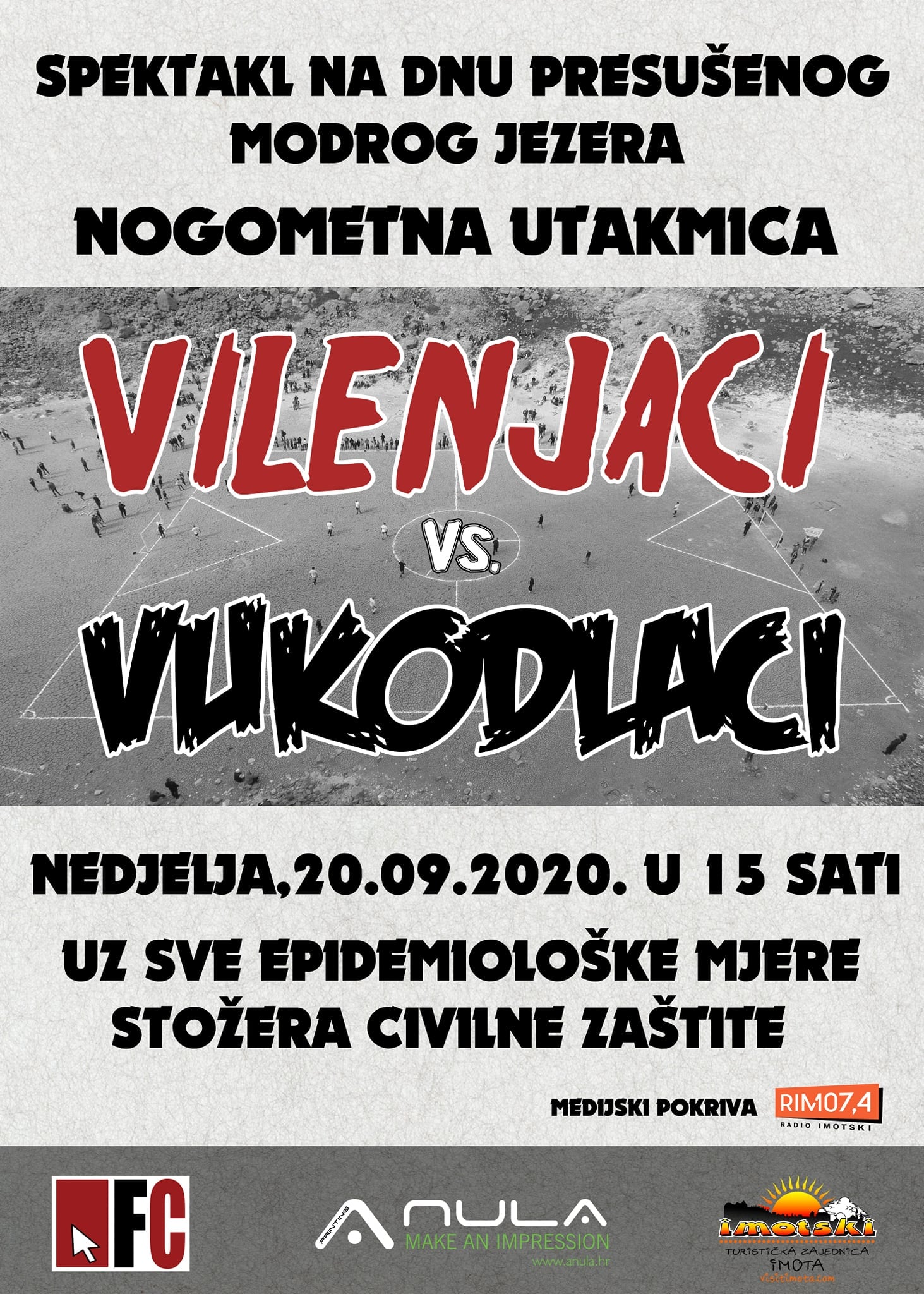
The funny thing is, however, that Imotski regularly features in global lists of the top 10 strangest football stadiums in the world, but for quite another football pitch.
That honour goes to the Gospin Dolac stadium, which is built into the Imotski rock, less than a football kick away from the Blue Lake - this is how it looks in more normal times.
If only the compilers of these lists knew the true secrets of Imotski's truly bizarre football pitch heritage.
For the latest travel info, bookmark our main travel info article, which is updated daily.
Read the Croatian Travel Update in your language - now available in 24 languages
Official Recommendations, Instructions for Crossing the Croatian Border
September 18, 2020 - The official koronavirus.hr website has published updated recommendations and instructions for crossing the Croatian border.
Recommendations and instructions of the Croatian Institute of public Health for passengers crossing the state border of the Republic of Croatia.
Important note: Valid till 30th of September
The Decision on temporary prohibition of crossing the border crossings of the Republic of Croatia (NN 74/20) prohibits or restricts the crossing of passengers through border crossings, of which are exempt:
- EU nationals (irrespective of their place of residence), the Schengen area and Schengen associated countries, as well as members of their families and third-country nationals who are long-term residents under Council Directive 2003/109/EZ of 25 November 2003 on the status of long-term nationals of third countries and persons entitled to stay under other EU or national Directives or having national long-term visas.
- The temporary prohibition on entry into the Republic of Croatia from third countries, with the exception of passengers referred to in point 1, shall not apply to:
2a) Health care professionals, health researchers and associates, nursing professionals and persons requiring urgent medical treatment
2b) Cross-border workers
2c) Carriers of goods and other transport personnel to the extent necessary
2d) Diplomats, police officers in the performance of their duties, civil protection services and teams, staff of international organisations and international military personnel in the performance of their functions
2e) Transit passengers
2f) Passengers travelling for tourism or other business reasons or having other economic interest, and passengers travelling for the purpose of education
2g) Passengers travelling for urgent personal reasons (e.g. they own a property in the Republic of Croatia) or have any other immediate personal reason
Instructions for the health supervision of passengers entering the Republic of Croatia from third countries:
a) For all passengers entering the Republic of Croatia from third countries, under exemption from the prohibition to cross the border referred to in point 2g, health supervision with 14 days quarantine/self-isolation is mandatory.
Quarantine/self-isolation can be shortened to seven days if a passenger does a nasal and pharynx swab at his/her expense seven days after entering Croatia and gets a negative PCR test result for SARS-CoV-2.
b) The obligation of self-isolation for passengers entering the Republic of Croatia from third countries does not apply to passengers referred to in points 2a, 2b, 2c, 2d, and:
2e) Transit passengers:
- For transit passengers, the border police will, after they have been granted entry, check whether they have left the territory of the Republic of Croatia within 12 hours
- This rule can only be applied if the departure from the Republic of Croatia to a neighbouring country enables it to enter.
2f) – Passengers entering the Republic of Croatia for tourism or other business reasons or having other economic interest, as well as persons travelling for educational purposes.
These passengers may enter Croatia without the obligation of self-isolation upon presentation of a negative nasal and pharynx swab test for SARS-CoV-2, not older than 48 hours (starting from the time of taking the swab until arrival at the border crossing), or with the obligation of 14 days quarantine/self-isolation if they do not have a negative PCR test.
If third-country nationals have a test older than 48 hours when entering Croatia, they will be allowed to enter Croatia, however, they will be obligated to self-isolate and re-test themselves in Croatia at their own expense. The above can be applied to passengers and crew members on yachts. Persons who do not present a negative PCR result are subject to a mandatory 14-day quarantine / self-isolation measure.
Persons who have a negative PCR test, and are on the self-isolation list, whether they’ve been on the list for seven days, as stated in point 2g, or have re-tested themselves in the case they have a test older than 48 hours when entering Croatia, are to be removed from the self-isolation list.
Passengers entering Croatia without the obligation of self-isolation shall comply with the following measures during the first two weeks of their stay in Croatia:
- During the first 14 days after entering the Republic of Croatia, exits from accommodation are limited only to the necessary ones: performance of work if it is a business reason for entering the Republic of Croatia, performance of necessary activities with continuous intensified implementation of hygiene measures.
- During the necessary exit from accommodation it is recommended to use a mask or covers for the nose and mouth, maintain physical distance from other persons (minimum 1.5 meters) and conduct hand hygiene.
- Hands wash as often as possible with warm water and soap and/or use a hand disinfectant that needs to be rubbed in the palms. Avoid touching the face, mouth, nose and eyes.
- Avoid the use of public transport. In a means of transport, it is desirable that a person is alone or exclusively with persons sharing a common accommodation.
- Gatherings should be consistently avoided
- During business meetings it is necessary to meet as few people as possible, ensure a physical distance of 1.5 meters and availability of disinfectants, and avoid unnecessary meetings.
- Payment services are performed by non-cash card payments or on-line services.
- Every morning it is necessary to measure the body temperature if it is higher than 37.2C, the measurement should be repeated after 10 minutes, and if the temperature is higher than 37.2 C it is necessary to stay at home/in accommodation and contact a doctor in a tourist or COVID-19 infirmary or a territorially responsible epidemiologist.
- In case of symptoms of acute respiratory infection (cough, sore throat, fever, short breathing/difficulty or loss of smell), it is necessary to stay at home/in accommodation and contact a doctor in a tourist or A COVID-19 infirmary or a territorially responsible epidemiologist.
- In case of sudden onset of severe, life-threatening symptoms, contact emergency medical service at 194.
For the latest travel info, bookmark our main travel info article, which is updated daily.
Read the Croatian Travel Update in your language - now available in 24 languages!
Official COVID-19 in Croatia Weekly Report September 8-14
September 18, 2020 - The latest official COVID-19 in Croatia weekly report has been released by the Koronavirus government website, covering September 8-14.
CIPH report for the previous 7 days and daily report for the Republic of Croatia on the 14th of September 2020.
| Confirmed cases 13 598 | Recovered 11 151 | Deaths 227 | Active cases 2 220 |
| Tested 225 014 | Hospitalized 310 | On a respirator 22 | Self-isolation 8 217 |
| A total of 120 people died in this epidemic wave. Most of the deceased had significant comorbidities or were of advanced age. The average age of the deceased in this epidemic wave is 76.7 years. Forty-eight people died on a respirator. | |||
There are currently 22 testing places in the Republic of Croatia that perform RT-PCR analysis and collect samples. All processed samples enter national Croatian Health Insurance Institute platform, which is accessible to all county public health institutes. County public health institutes submit data about positive cases, sources of infection and hotspots as part of their daily reports to the Croatian Institute of Public Health. The Croatian Institute of Public Health collects information about hotspots, hospital treatment of COVID-19 positive persons, COVID-19 positive patients on respirators and the deceased. You can find more about the test centers available at the link.
Epidemiological indicators on 14 th of September:
Cumulative 7-day incidence rate for the Republic of Croatia: 37,1/100 000
- Cumulative 14-day incidence rate for the Republic of Croatia: 81,4/100 000
- Counties with a cumulative 7-day incidence rate greater than 50/100 000 inhabitants: Brodsko-posavska, Dubrovačko-neretvanska, Požeško-slavonska, Splitsko-dalmatinska, Virovitičko-podravska, Zadarska
- Counties with a cumulative 14- day incidence rate greater than 100/100 000 inhabitants: Dubrovačko-neretvanska, Požeško-slavonska, Splitsko-dalmatinska, Šibensko-kninska, Virovitičko-podravska, Zadarska
- Total number of tests in the last week: 31 861
- Share of positive tests in the total number of tests in the last week: 4,8 %
- Total number of tests and share of positive tests in total number of tests: 225 014, 6,04 %
- The number of new cases in intensive care per 100,000 inhabitants in the last 7 days: 0,4/100 000
- Number of deaths in the last week: 26
- Total death rate per 1 000 000 population: 55,5/1 000 000
Epidemiological situation in Croatia
In a two-week period from 1st of September to 14th of September all counties recorded new cases of COVID-19 disease. The highest number of new cases are recorded in the Splitsko - dalmatinska County, followed by the City of Zagreb and Dubrovačko-neretvanska County. The lowest number of new cases were recorded in Međimurska and Varaždinska County. The Splitsko - dalmatinska County also has the highest 14-day rate, followed by Dubrovačko-neretvanska and Požeško-slavonska County.
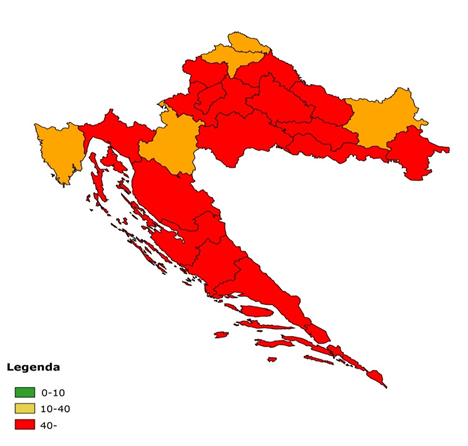
| CITY OF ZAGREB | 76,1 |
| BBC | 93,6 |
| BPC | 97,8 |
| DNC | 184,8 |
| ISTARSKA C. | 32,6 |
| KARLOVAČKA C. | 37,7 |
| KKC | 50,1 |
| KZC | 42,3 |
| LSC | 97,4 |
| MEĐIMURSKA C. | 21,8 |
| OBC | 33,5 |
| PSC | 147,4 |
| PGC | 57,3 |
| SMC | 43,1 |
| SDC | 195,3 |
| ŠKC | 104,8 |
| VARAŽDINSKA C. | 25,2 |
| VPC | 107,6 |
| VSC | 53,8 |
| ZADARSKA C. | 117,7 |
| ZAGREBAČKA C. | 53,0 |
| TOTAL | 81,4 |
Figure 1. 14-day rate by counties
Epidemic by weeks, from 19 th – 29 th week of the epidemic
In the period from 29 th of June to 13th of September 2020, the number of cases per week (from the 19 th to the 29th week of the epidemic) was from 460 to 1,948 and the rate from 11.3 to 47.6 per 100,000 inhabitants. The number of tests performed per week was ranged from 7,957 to 24,722 and the share of positive tests in those tested per week ranged from 4.3 to 12.5%. During this period, the weekly number of cases and the percentage of positive tests in the weekly number of tested varied. An overview is given in Table 1.
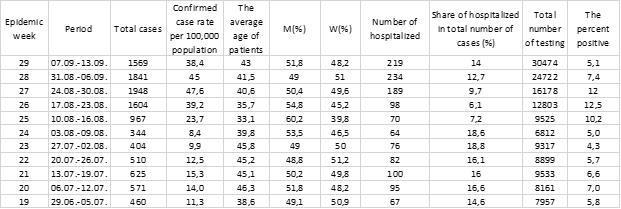
Table 1. Overview of the number of confirmed cases by weeks, from week 19 th – 29 th
In the period from 29 th of June to 14th of September 2020, the number of cases per week (from the 19 th to the 29th week of the epidemic) was from 460 to 1948. The number of deceased varied from 1-16 and showed increase in the 29th week of the epidemic. The share of deceased on the respirator ranged in the weekly number of deaths from 16.7-60%. The mean age of deceased was 75 years or more, except in the 21 st week of the epidemic, when the mean age of death cases was 72,7 years.
The death rate ranged from 0.1 in the 19 th week of the epidemic to 0.3 in the 23rd and 28 th week of the epidemic with an increase in the 29 th week of the epidemic when it was 0.6. An overview is given in Table 2.

Table 2. Overview of patients on respirator and deaths by weeks, from week 19 th – 29 th
Table 3 shows the incidence of the 7-day rate in the two last weeks with a limit of 50/100 000 inhabitants, which in some countries is taken as one of the criteria in assessing the epidemiological situation. In most counties, the 7-day rate is generally stable or slightly declining.
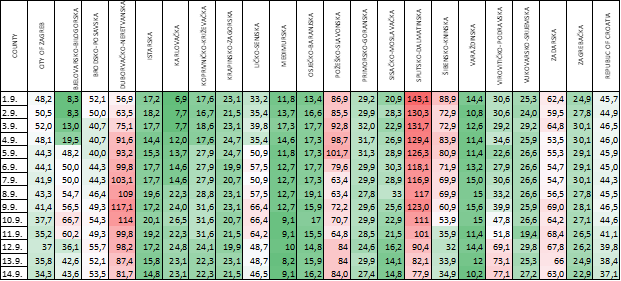
Table 3. Overview of 7-day incidence rates per 100,000 population in the last week
Clinical aspects - hospitalized, on a respirator and recovered in the last week
Figure 2 shows the relationship between the daily number of confirmed cases and the daily number of hospitalized cases. Number of hospitalized cases per day ranged between a minimum of 17 and a maximum of 42, while the share of hospitalized cases in the total daily number of confirmed cases ranged from 9.7% to 26.2%.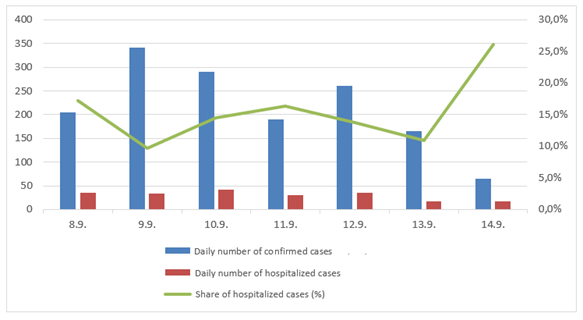
Figure 2. Overview of the daily number of confirmed and hospitalized cases (8.9.-14.9.)
Figure 3 shows the proportion of hospitalized in the total number of weekly cases. In the last week, 230 people were hospitalized, which is 14% of the total number of patients in the given period. In the same period, 16 people were put on a respirator, which makes 1,1% of the total number of confirmed cases.
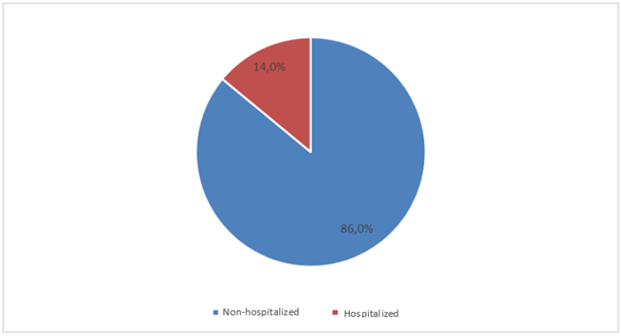
Figure 3. Relation of the total number of confirmed and hospitalized cases (8.9.-14.9.)
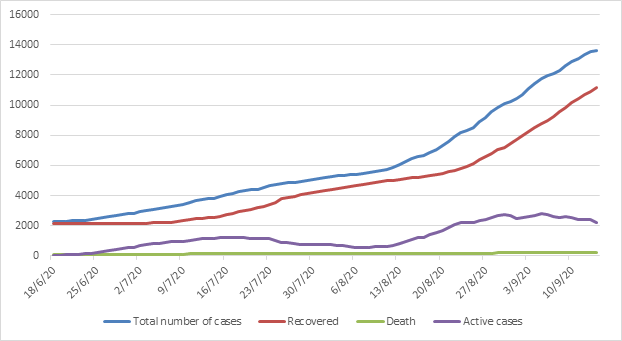
Figure 4. Total number of cases, recovered, deceased and active number of cases from 18.6.- 14.9.
Died from COVID-19, 8 th of September – 14 th of September 2020, age and sex
A total of 120 people died in this wave of epidemics. Most of the people who died had significant comorbidities or were of advanced age. The mean age of the deceased in this wave of epidemics is 76.4 years. Forty-eight people died on a respirator.
An overview of the situation is given in Table 4 and Figure 5.
| AGE GROUP | 40-49 | 50-59 | 60-69 | 70-79 | 80-89 | 90-99 | 100+ |
| MEN | 1 | 7 | 15 | 30 | 17 | 4 | 0 |
| WOMEN | 0 | 0 | 6 | 9 | 25 | 5 | 1 |
Table 4. Distribution by age and sex of the deceased persons
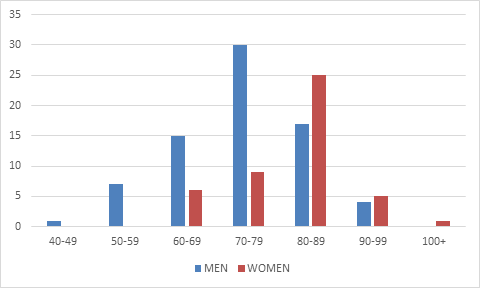
Figure 5. Age and sex distribution of deaths from COVID-19 in the period 29 th June – 14th of September 2020
In the last week, 26 people died, of which 10 (38.5%) were on a respirator. The distribution by age and sex in the last weeks is shown in Table 5, and by counties in Table 6.
| AGE GROUP | 40-49 | 50-59 | 60-69 | 70-79 | 80-89 | 90-99 |
| MEN | 1 | 2 | 1 | 6 | 6 | 3 |
| WOMEN | 0 | 0 | 2 | 2 | 3 | 0 |
Table 5. Distribution by age and sex of the deceased people in the last week
Hotspots
In the last week, new cases were recorded in all counties of continental Croatia, but mostly in the City of Zagreb, Brodsko - posavska and Zagrebačka County. The highest 7-day rates on 14 th of September were in Požeško - slavonska, Virovitičko - podravska and Brodsko – posavska County. There is still influx of patients whose source of infection is associated with holidays on the Adriatic, but their share is significantly reducing. The number of wedding celebrations at which patients were registered increased, but at most there was no large spread among the guests. A larger influx of patients was recorded at wedding celebrations in Brodsko - posavska, Varaždinska, Bjelovarsko - bilogorska and Vukovarsko - srijemska Counties. In Požeško - slavonska County, patients are recorded in connection with the prom dinner and the sacral event. In the City of Zagreb, a grouping of patients was recorded in connection with an organized event in the Splitsko - dalmatinska County. The grouping of patients was recorded in health care institutions in the City of Zagreb, Brodsko - posavska and Virovitičko - podravska Counties and institutions for social care in Sisačko - moslavačka County. Cases of the disease have also occurred in schools, but there has been no significant spread among students and staff. Part of the sick people are cases imported from abroad and there is a large proportion of contacts of sick people.
Coastal Croatia
Cases of ill persons have been recorded in Coastal Croatia like in all counties as well. The highest number of patients was recorded in the Splitsko - dalmatinska, Dubrovačko - neretvanska and Zadarska County. The highest 7-day rate is in the Splitsko - dalmatinska, Dubrovačko - neretvanska and Zadarska County. In the Splitsko - dalmatinska County, smaller groupings were recorded in two monasteries. In the Primorsko - goranska County, a significant number of patients was recorded this week as well, related to an organized cultural event in the open air and a smaller grouping of patients was also recorded in the preschool institution in the Istria County. In Zadarska County, there are two kindergartens in self-isolation and a class in one school building. Groupings of patients were also recorded at the workplace in Dubrovačko - neretvanska County and Šibensko - kninska County. The patients were also recorded in a home for the elderly in Ličko – senjska County. There were patients from wedding celebrations in Zadarska County and Ličko – senjska County, as well as in the continental part of Croatia. Although sick people have appeared at multiple weddings, there wasn’t a great spreading among guests. A significant proportion of patients are contacts of previously recorded cases.
Age-sex distribution of patients in the last week
In the previous week, a total of 1,517 people fell ill - approximately the same number of males, 732 (48.3%) and females, 785 (51.7%). The same distribution by sex is present in most age groups, except in the age group 1-6 years where twice as many girls were recorded and in the age group 41-50 years of age where more women became ill than men.
By age groups - 160 children fell ill and they make the smallest share (10.5%) in the ill people in the past week. The least affected were children under 1 year of age, a total of 2, and children in lower grades of primary school, a total of 15. The most affected were children of secondary school age, a total of 33. In general, adults made the largest share in the total number of patients last week 1142 (75,3 %).
In contrast to previous weeks, there is a shift in the age of patients towards higher age groups. The largest share, 21.9% (332 cases) are people aged 51-65, while a one - fifth of patients (145 or 18.9%) in the last week are young adults aged 19 to 30 years. The lowest number of patients in the age group is 66 and older (215 or 14.2%), although this number is not negligible because it is in this group of patients that the highest number of concomitant comorbidities is observed, which are associated with increased risk in COVID-19 from the development of a more severe clinical picture.
The full view can be found in Figure 6 and Table 6.
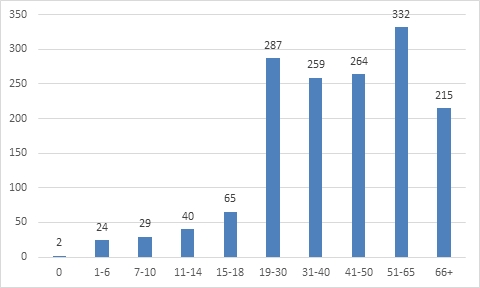
Figure 6. Distribution of patients in the last week by age groups
Measures
Measures to maintain physical distance, maintain hand hygiene and disinfection are still in force. Also, it is mandatory to wear face masks or medical masks indoors for all health workers and professionals, employees who work in social care system and the ones who work in hospitality facilities
Decisions of the Headquarters
- September 8 - Decision about amendments to the Decision about the introduction of necessary epidemiological measures for the Brodsko - posavska County
- September 8 - Decision about the introduction of new epidemiological measures for the area of the City of Otočac
- September 9 - Decision about amendments to the Decision about the introduction of necessary epidemiological measures for the area of Zadarska County
- September 9 - Decision amending the Decision about the introduction of necessary epidemiological measures for the area of Splitsko - dalmatinska County
- September 11 - Decision amending the Decision about the introduction of necessary epidemiological measures for the area of Dubrovačko - neretvanska County
- September 11 - Decision about the introduction of necessary epidemiological measures for the area of Virovitičko - podravska County
- September 11 - Decision about the introduction of necessary epidemiological measures for the Zagrebačka County
CIPH recommendations
- Recommendations for the prevention of COVID-19 infection in the activity of multiplex cinemas in shopping malls
- Instructions for the implementation of the state matriculation exam during the coronavirus epidemic (COVID-19) autumn deadline - August and September 2020
- Supplement to the recommendation for the prevention of COVID-19 infection in the catering industry of nightclubs
- Possibilities of conducting extracurricular classes related to the COVID-19 pandemic
- Instructions for prevention and suppression of the COVID-19 epidemic related to the work of preschool institutions, primary and secondary schools in the school year 2020/2021.
- Recommendations for manufacturers of textile masks intended for schools
- Guidelines for the prevention and control of the COVID-19 epidemic in student dormitories with regard to the COVID-19 epidemic in the school year 2020/2021.
- Recommendations for the operation of dance schools during the coronavirus epidemic (COVID-19)
- Recommendations for the operation of art schools during the coronavirus epidemic (COVID-19)
- Priorities for testing for SARS-CoV-2, on contact handling, completion of isolation and self-isolation (Consolidated revised recommendations)
- Diseases and health conditions that may increase the risk for more severe forms of COVID-19 disease
- Selected health and organizational issues related to the work of preschool institutions, primary and secondary schools in the school year 2020/2021
- Recommendations for teaching at higher education institutions in the period of the COVID-19 pandemic with the application of anti-epidemic measures
- Organization of rest and food - Work of preschool institutions, primary and secondary schools in the school year 2020/2021 - additional clarifications
- Visors cannot replace masks except when a student / person has a problem with hearing impairment - Work of preschool institutions, primary and secondary schools in the school year 2020/2021 - additional clarifications
Recommendations and measures on global and EU level
Europe
On 10th of August 2020, ECDC released an updated version of the risk assessment. ECDC has additional documents and information available:
The number of cases and the 7-day cumulative incidence of COVID-19 confirmed cases worldwide can be found on the ECDC dashboard:
https://qap.ecdc.europa.eu/public/extensions/COVID-19/COVID-19.html
Austria
Bundesministerium für Soziales, Gesundheit, Pflege und Konsumentenschutz - https://www.sozialministerium.at/Informationen-zum-Coronavirus/Neuartiges-Coronavirus-(2019-nCov).html
Netherlands
Government of the Netherlands - https://www.government.nl/topics/coronavirus-covid-19
National Institute for Public Health and the Environment - https://www.rivm.nl/en/novel-coronavirus-covid-19
Germany
Rober Koch Institut - https://www.rki.de/DE/Home/homepage_node.html
Slovenia
(gov.si) - https://www.gov.si/en/topics/coronavirus-disease-covid-19/
National Institute for Public Health – Slovenia - https://www.nijz.si/en
United Kingdom
gov.uk – https://www.gov.uk/coronavirus
NHS - https://www.nhs.uk/conditions/coronavirus-covid-19/
World
WHO provides comprehensive information and documents. WHO COVID-19-Dashboard:
Coronavirus disease (COVID-19) Weekly Epidemiological Update and Weekly Operational Update i Weekly Surveillance Report:
- https://www.who.int/emergencies/diseases/novel-coronavirus-2019/situation-reports
- https://www.euro.who.int/en/health-topics/health-emergencies/coronavirus-covid-19/weekly-surveillance-report
Sources of information
https://www.hzjz.hr/
https://zdravlje.gov.hr/
Information about the global epidemiological situation
More about COVID-19 in other countries can be found and learned on the ECDC website: https://www.ecdc.europa.eu/en/geographical-distribution-2019-ncov-cases
The WHO Regional Office for Europe, the European Commission and the European Observatory on Health Systems and Health Policy have at their disposal the COVID-19 Health System Response Monitor (HSRM). There is information available about European countries and ways to respond to this epidemic. The focus is on health systems and public initiatives: https://www.covid19healthsystem.org/mainpage.aspx
For the latest travel info, bookmark our main travel info article, which is updated daily.
Read the Croatian Travel Update in your language - now available in 24 languages!
Flights to Croatia: easyJet Maintains 11 Lines to Croatia in October, Croatia Airlines to 15 European Destinations
September 18, 2020 - The latest news for flights to Croatia as easyJet maintains 11 lines to Croatia in October, and Croatia Airlines flies to 15 European destinations.
Croatian Aviation reports that British easyJet has made some changes to its flight schedule. Numerous lines that were announced for October will now stop flying at the end of September. The company will keep 11 lines in October, mostly with a minimum number of weekly operations.
Lines to Zadar and Pula
The company will cut off traffic on two routes to Pula, from Bristol and London Gatwick, by the end of September, while the line from London Luton made its last flight last Saturday (September 12).
It is the same at Zadar Airport. The last flight to Zadar will be operated by easyJet this Saturday (September 19) on the route from Luton, while the route from Gatwick ended with traffic last Saturday. easyJet operated in Pula and Zadar in previous years in October, but this year will not happen.
Lines to Split and Dubrovnik
By the end of September, easyJet will cancel two lines to Split: from Belfast and Amsterdam. The following lines remain in operation:
Split - Basel (until 24.10),
Split - Bristol (until 24.10),
Split - Geneva (until 24.10),
Split - Glasgow (until 25.10),
Split - Gatwick (until 31.10),
Split - Luton (until 24.10),
Split - Manchester (until 27.10.).
Traffic on the mentioned lines will be modest in October, as the company generally announces one flight a week. As for Dubrovnik, easyJet will cancel only one line, Dubrovnik - Geneva, at the end of September, and the following will remain in traffic:
Dubrovnik - Bristol (until 28.10),
Dubrovnik - Edinburgh (until 24.10),
Dubrovnik - Gatwick (until 31.10),
Dubrovnik - Manchester (until 24.10).
The company will also operate on these routes once a week through October, and further cancellations are also possible, depending on the booking for each flight.
Slobodna Dalmacija reports that in October this year, Croatia Airlines will continue to connect Croatia with the most important European capitals and transport hubs, and air connections within Croatia will continue to be provided to passengers on domestic scheduled flights.
During October, the national airline's aircraft will directly connect Croatia with 15 international destinations (Amsterdam, Vienna, Berlin, Brussels, Düsseldorf, Frankfurt, Copenhagen, London Heathrow, Lyon, Munich, Paris, Rome, Sarajevo, Skopje, and Zurich). Passengers from these traffic hubs are provided with favorable opportunities for connecting flights worldwide, especially on the flights of Croatia Airlines partners from the Star Alliance.
In international regular traffic, Zagreb will be directly connected to 12 European destinations; from Split, it will fly to 10 European capitals, from Dubrovnik to two international destinations. From Rijeka, it will continue to fly to Munich.
In domestic scheduled traffic, Croatia Airlines planes will connect Zagreb with five Croatian airports (Split, Dubrovnik, Zadar, Pula, and Bol on the island of Brac), and flights on the Osijek - Split and Osijek - Dubrovnik routes will continue.
During the peak of the tourist season, the company's planes directly connected Zagreb with 14, Split with 11, and Dubrovnik with 7 international destinations.
It should be emphasized that passengers' flight safety is still a priority in the business of Croatia Airlines. All protection measures, which the company implements against the coronavirus epidemic, are fully compliant with public health authorities and aviation authorities' decisions and recommendations.
The entire aircraft crew must use protective equipment and means (masks, gloves, disinfectants), air enters the aircraft's passenger cabin from the atmosphere and is purified with the most modern filters, and the aircraft is continuously disinfected. Also, passengers must wear face coverings and masks throughout their stay in the passenger cabin, and disinfectant wipes are readily available.
It is worth noting that due to the epidemiological crisis, Croatia Airlines offers its customers flexible conditions regarding the purchase of tickets and travel. In particular, passengers have at their disposal an unlimited number of changes to travel dates, free of charge, as well as a refund in the form of a voucher that can be exchanged for a new ticket within a year of issue.
For the latest travel info, bookmark our main travel info article, which is updated daily.
Read the Croatian Travel Update in your language - now available in 24 languages
Join the Total Croatia Travel INFO Viber community.
Flights to Croatia: Lufthansa Announces Frankfurt-Rijeka in 2021
September 17, 2020 - The latest news for flights to Croatia as Lufthansa announces Frankfurt-Rijeka in 2021.
Croatian Aviation reports that Germany's Lufthansa announced on Wednesday that it would introduce 14 new international routes from its base in Frankfurt in the summer flight schedule in 2021. Among others, the Frankfurt - Rijeka line is being introduced.
In the summer flight schedule, Lufthansa operates to five destinations in Croatia from Frankfurt: Zagreb, Pula, Zadar, Split and Dubrovnik, and from next summer season, the sixth destination in Croatia - Rijeka Airport will be added to the list.
On the line from Frankfurt, Ryanair used to operate to Rijeka, which moved its operations to Hahn this summer season, so Rijeka was without a direct flight with the main Frankfurt airport.
On the line between Frankfurt and Rijeka in the summer season of 2019, the German Condor also operated twice a week, but this year it did not launch that line due to the global pandemic. It will be interesting to see if this German airline returns to Rijeka in the 2021 season.
The new Lufthansa line will operate in the evening: departure from Frankfurt is scheduled for 17:35, and arrival in Rijeka at 19:00. The return flight will depart from Rijeka at 8 pm, while the arrival in Frankfurt is planned at 9:30 pm. The company leaves the possibility of adding more weekly flights on this route, which will primarily depend on the state of bookings. This company operates on the Munich - Rijeka route in the summer flight schedule, but this year it is not in traffic due to the impact of the global pandemic.
Tickets on this new line are already on sale on the Lufthansa website, and all tickets purchased through December 31 this year are flexible which means passengers are entitled to an unlimited number of travel date changes.
This is the third completely new line announced for next year's summer flight schedule. We remind you that Ryanair previously announced a new line Vienna - Pula, while TAP Portugal announced the introduction of the Lisbon - Zagreb line a few days ago.
For the latest travel info, bookmark our main travel info article, which is updated daily.
Read the Croatian Travel Update in your language - now available in 24 languages


